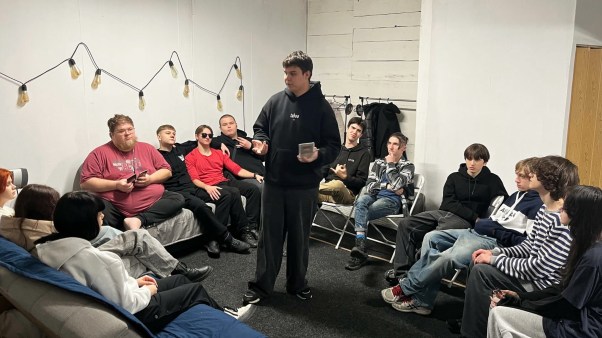One Sunday morning last year, greeters waved and held signs saying “You Belong Here” and “You Can Sit With Us” to welcome cars pulling up to SOCO Church, which meets in an event space in downtown Bentonville, Arkansas.
The worship band led the congregation in Hillsong’s “O Praise the Name” before a plaid-clad pastor in clear-framed glasses took the stage to preach. By the time the greeters returned to the sidewalks with their “See You Next Week” signs, 627 people had attended back-to-back services, and 14 of them made decisions for Christ.
All on their first Sunday as a church.
“I remember just weeping,” said Brad Hampton, who copastors SOCO (short for “souls” and “community”) with his wife, Jessica. “God is so faithful.”
Their year-and-a-half-old congregation belongs to the Association of Related Churches (ARC), a nondenominational church-planting network known for training planters to go big. Through starting more than 800 churches in the US over nearly 20 years, ARC leaders discovered that a large gathering on their first Sunday is a major factor helping churches become more sustainable in the long run.
ARC has leveraged its church planting expertise to come up with a playbook on how to successfully start a new church. And pastors aren’t expected to go it alone; the network relies on recent planters to coach the next round.
“Twenty years ago, you started a church in your house and you preached it up until you got enough people and enough money to go to a building,” said Josh Roberie, who oversees training and coaching for ARC. “We have a launch large strategy. You make the first day like an opening day.”
So far in 2019, new ARC church plants averaged 293 attendees on their first Sunday, the highest in the network’s history. That’s a big crowd for any church, since just 10 percent of existing Protestant congregations in the US draw more than 250 on a typical Sunday.
But ARC leaders recognize that dynamics are different at church plants than established churches. With their approach, plants need to begin with critical mass before numbers dip.
Plus, the dechurched and new believers ARC aims to attract are less likely to tithe right away, so they require a larger congregation to reach operational giving levels, said Amy Roberie, who works with ARC applicants. The goal is not to start megachurches, she said, but for congregations to be sustainable from day one.
The network coordinates two major launches a year, timed around peak church attendance at the start of the year in January and the school year in the fall. ARC plans to launch about 40 churches this September.
Planters work with coaches to develop a launch plan, resourcing them with examples of timelines, budgets, and legal steps.
“We were taught how to fundraise, how to build a team, and honestly just challenged to dream bigger and to ask bigger things,” said Hampton, whose church now averages 1,100 worshipers a weekend. “They shared information on how to get a building and what to look for: parking spots, square footage for kids’ areas, visibility, and on and on.”
ARC’s training includes strategies to recruit a core team of volunteers, hold “start-up parties” to meet people and offer a quick invite to join, plan the logistics of holding a service in rented spaces like schools and movie theaters, and promote the launch date.
“If you invest the resources up front to have an excellent launch, to market your launch and build your team . . . you spend less money over the first 10 years,” Amy Roberie said. Some ARC churches will spend over $100,000 on their launch, with the network matching up to $50,000 in a no-interest loan, which funds future church planters when repaid.
ARC reports that 90 percent of their church plants continue in operation after five years. (By comparison, the Southern Baptist North American Mission Board said in a 2018 report that about 76 percent of its plants survived five years.)
While branding may appeal to outsiders—billboards, matching T-shirts, and stylish logos—pastors say they are drawn to ARC’s noncompetitive approach.
The network requires potential planters to be sent by another church and bars them from recruiting from nearby congregations, going as far as instructing them to meet with area pastors for advice on how to serve the community.
Six pastors—including ARC president Greg Surratt of Seacoast Church in Charleston and Dino Rizzo, ARC’s executive director—founded the ARC in 2000, hoping to use their relationships to develop a model and funding mechanism for church planting. Their initial $25,000 went to what have become two of the biggest congregations in the country: Church of the Highlands in Birmingham, Alabama, now with 22 campuses, and New Life Church in Little Rock, Arkansas, now with 17 campuses.
In 2018, ARC spent $7 million on church planting. Last fall, for the first time, the number of new churches planted on the West Coast outnumbered those on the East Coast, including a 900-person launch at The Father’s House OC, co-pastored by Bianca Olthoff. The church celebrated its “half birthday” this spring with a baptism party complete with a DJ, party hats, balloons, and mini bundt cakes. Another prominent Southen California ARC affiliate is Chad Veach’s Zoe Church LA, a trendy congregation popular with Hollywood’s faithful.
The ARC network has made a name for itself in the church-planting landscape—it’s better known among pastors than among typical churchgoers—and its reputation is growing along with its totals, now at 842 churches. (Acts 29, for one comparison, numbered 740 at the start of the year.)
ARC is “offering things that other networks are offering: coaching, training, networking, mentoring, and financial resources,” said J.D. Payne, ministry professor and author of Discovering Church Planting. “The major difference involves the large scale on which they are working with a variety of ministry partners to get churches started.”
While celebrating its success, fellow church planting experts offered some cautions about ARC’s model, noting that not all planters can swing the high cost up front and not all “unchurched” Americans will be drawn to its setup.
“I get concerned when leaders become only enamored by the large-launch, large-investment styles of planting, while not really considering the missiological challenges that accompany it,” said Chris Backert, national director of the Ecclesia Network. “We need all kinds of new expressions of church at this moment.”
ARC church planters emphasize the importance of their approach drawing new people into church community as a first step for transformation.
“People from the outside may focus on our systems and strategies. Those have been different than what was done 20 years ago. They’re innovative, they’re awesome, and working great,” said ARC trainer Josh Roberie, “but if they don’t get people into a life-giving church where people are the priority and Jesus is at the center, then none of those things matter.”
Kate Shellnutt is senior news editor at Christianity Today.
Have something to say about this topic? Let us know here.









